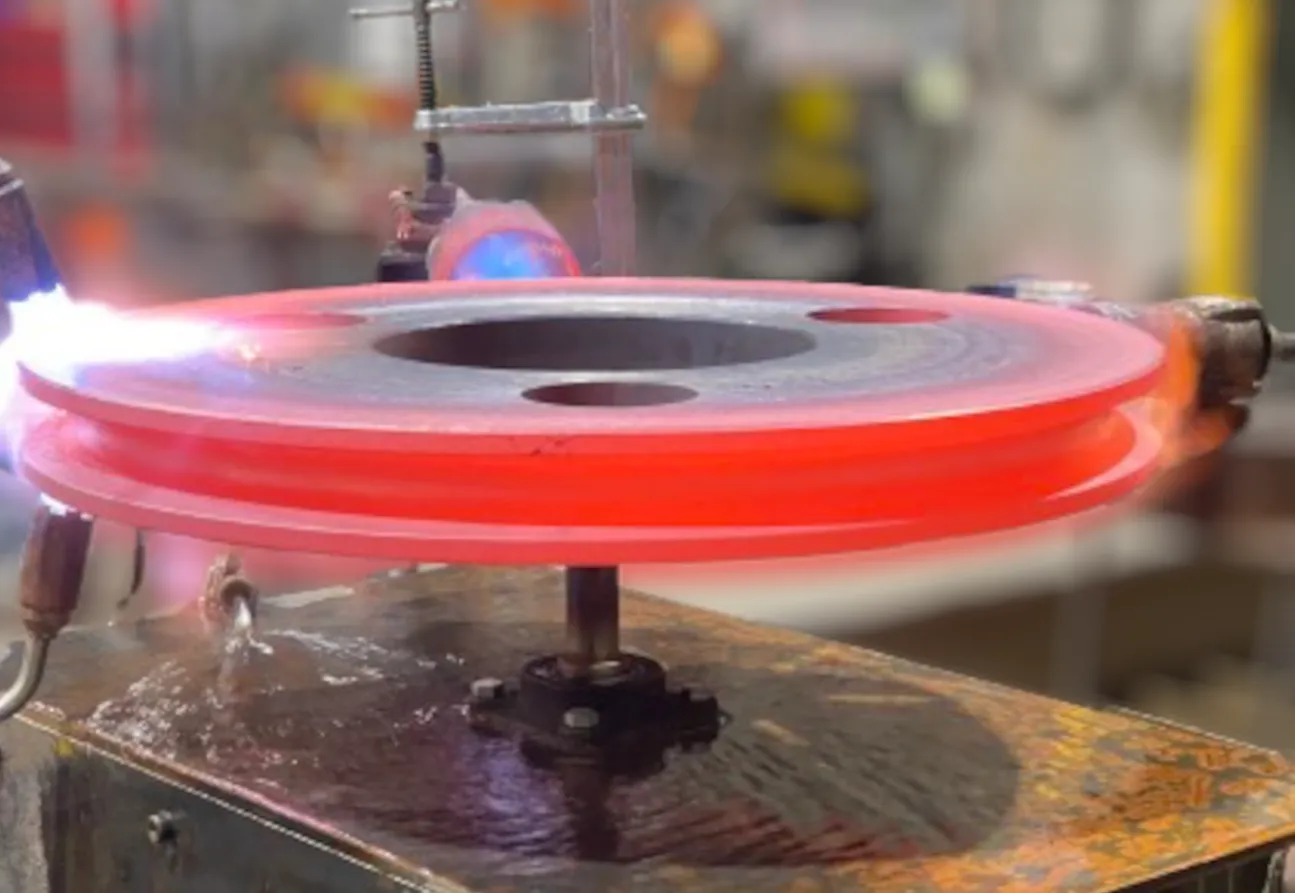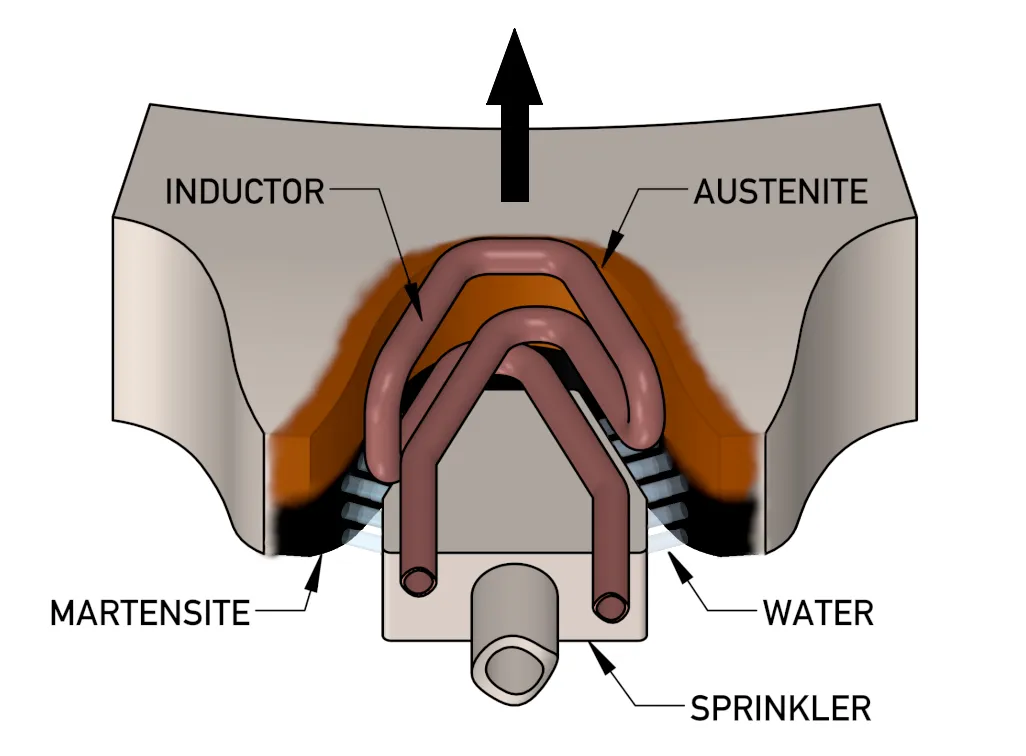Best Value: Long Link Mill Chain or Engineered Chain?
There are two main types of industrial chain: round link chain and engineered chain. While engineered chain for power transmission […]
Read MoreAugust 26, 2024 | Articles
Contents:
What Happens When Steel Is Heated?
What’s the Difference Between Hardened and Mild Steel?
Flame vs Induction Hardening Summary

When steel is heated, its internal structure changes, taking a cubic crystalline shape called austenite. This form of steel has a more open cell structure, allowing the metal to absorb more carbon. If allowed to cool slowly, this austenite releases the carbon slowly, and the metal regains its standard properties.
However, if the metal is cooled rapidly while in its austenitic form, the carbon does not have time to diffuse back into the surrounding metal structure. Instead, the carbon is trapped by the crystal structure, forming a needle-shaped crystal structure within the steel known as martensite. Martensite is a phase of steel that can be surface hardened or through hardened.
Carbon steel is a robust material that is already quite strong in its base state, but its ability to be altered to fit different applications is what makes it so essential to modern industry.
Once carbon steel has been cast or forged into a final product and cooled, flame or induction hardening will result in surface hardened steel.
Because the heat is applied at the surface without penetrating fully to the core of the steel, the resulting steel has a hard crystalline exterior, while the core retains the more ductile structure it was forged with.
High carbon steel is ideal for use cases involving repetitive work where mild steel would wear out too quickly under load, or through contact with abrasive or corrosive materials.
You can read all about the types of steel and their strengths and weaknesses on our blog, but the difference in steel formulations comes down to strength vs hardness. Hardened steel is prone to cracking under pressure. In similar situations, mild steel will simply flex and return to its original shape unless exposed to sufficient pressure to bend the metal permanently. Mild steel is therefore a more appropriate fit for applications such as construction, where the ability to flex and sway may save a building from collapse in the event of an earthquake or gale force winds. Hardened steel in this situation would not bend, instead forming cracks in the structure, compromising the integrity of the building.
However, in an application such as sprocket manufacturing, surface hardened steel teeth create a wear-resistant surface that greatly extends the useable life of the sprocket, while the ductile core keeps the sprocket from fracturing under the pressure of shock loads and heavy, repetitive work.

Steel can be heated for hardening purposes using either flame or by induction heat. In flame hardening, a high-intensity flame is channeled through a torch or a custom rig that dissipates the flame across the surface of the steel until the metal is heated to a specified temperature. Correctly assessing the temperature of the steel is one of the skills of an experienced steelworker, and with experience can be done by eye.
This process can be applied to a targeted area, such as the wear surface of a sprocket tooth, to harden only the required areas, retaining the resilience of the steel while extending the life of working surfaces.
Because the flame requires time to heat the metal, sometimes taking up to a half hour or more to heat a large surface, the underlying metal is heated as well, but to a lesser degree, alongside the surface. This restricts the minimum depth that flame hardening can achieve. Because of this, flame hardening is ideal for applications requiring a hardness depth of 1.5mm (1/16”) or more.

Induction hardening is a much quicker process than flame hardening. Induction involves shaping a highly conductive water-cooled copper coil around an object, and running an electrical current through it. This creates an electromagnetic field within the the coil. When a steel part, such as a sprocket tooth, enters the field, eddy currents are produced in the steel. These currents flow against the natural electrical resistance of the metal, causing it to heat up rapidly.
Since the intensity of the current can be easily adjusted, heating steel with induction happens in seconds instead of minutes, applying heat evenly across the surface of the steel that is within range of the copper coil.
Once fabricated, this same induction setup can be used repeatedly with items of the same shape, making it ideal for hardening items in batches.
The setup cost involved with induction is higher than a typical flame hardening setup, as each different item to be hardened will require a bespoke copper coil to be fabricated in a way that completely surrounds the surface to be hardened.
Additionally, because the induction coil must be bent to match the contours of the steel surface, the complexity of shape appropriate for induction hardening is restricted to fairly straightforward profiles.
| Flame Hardening | Induction Hardening |
| Steel is heated using oxy-acetylene flame, or other high intensity flame | Steel is heated using a/c current passed through an induction coil |
| Temperature is gauged and controlled by the operator | Temperature is easily regulated by digitally controlling voltage |
| Heating is gradual, may require holding period | Heating happens quickly |
| Most effective for individual items or small batches | Work is easily automated and replicated at scale |
| Not effective for hardening depth less than 1/16” | Can be used to create ultra-shallow hardened layer, <1/16” |
| Low equipment and maintenance cost | High equipment and maintenance cost |
| Appropriate for targeted application, flat or very large surfaces | More difficult to use on isolated surfaces, or in very large applications |
| Can be used on items with irregular shape | Best used on items with basic shape |
| Requires skilled labor | Can be done by unskilled labor |
| Cost effective when small quantity required | Cost effective at scale |
| Overheating can result in damage due to warping, scaling, and decarburization | Easy to avoid damage due to finely attuned heat |
| Common Applications: Large engineered sprocketsDrum sprocketsWear plates | Common Applications: Roller chain sprocketsCable sheaves and pulleysGears |
| Control variables:Gas flowDistance between flame and surfaceTime under heat | Control variables:Frequency of a/c currentResistance of metal compositionTime under heatShape and quantity of copper induction coil |
Still unsure about what material and hardness will be the best for your application? Give us a call. Our qualified engineers and technicians will make sure you end up with the right solution for your application.
There are two main types of industrial chain: round link chain and engineered chain. While engineered chain for power transmission […]
Read MoreOne question we get all the time is “What’s the difference between surface hardened and through hardened steel?”. While both […]
Read MoreAs a company that makes sprockets all day every day, and North America’s biggest made-to-order sprocket manufacturer, we get questions […]
Read More